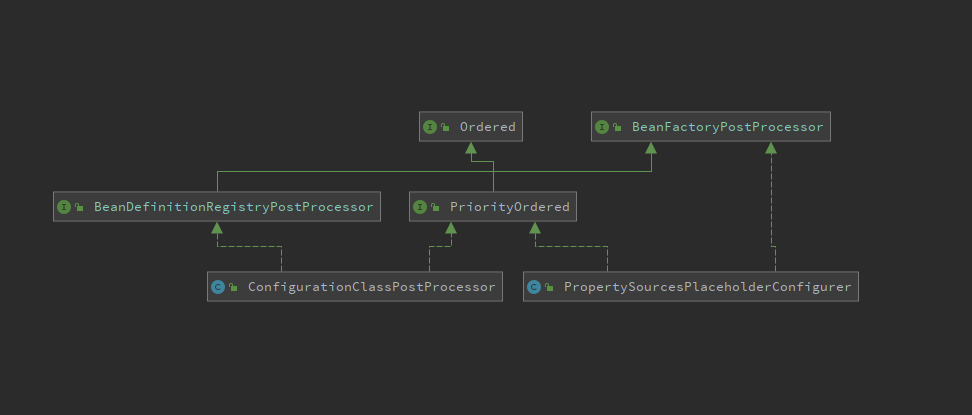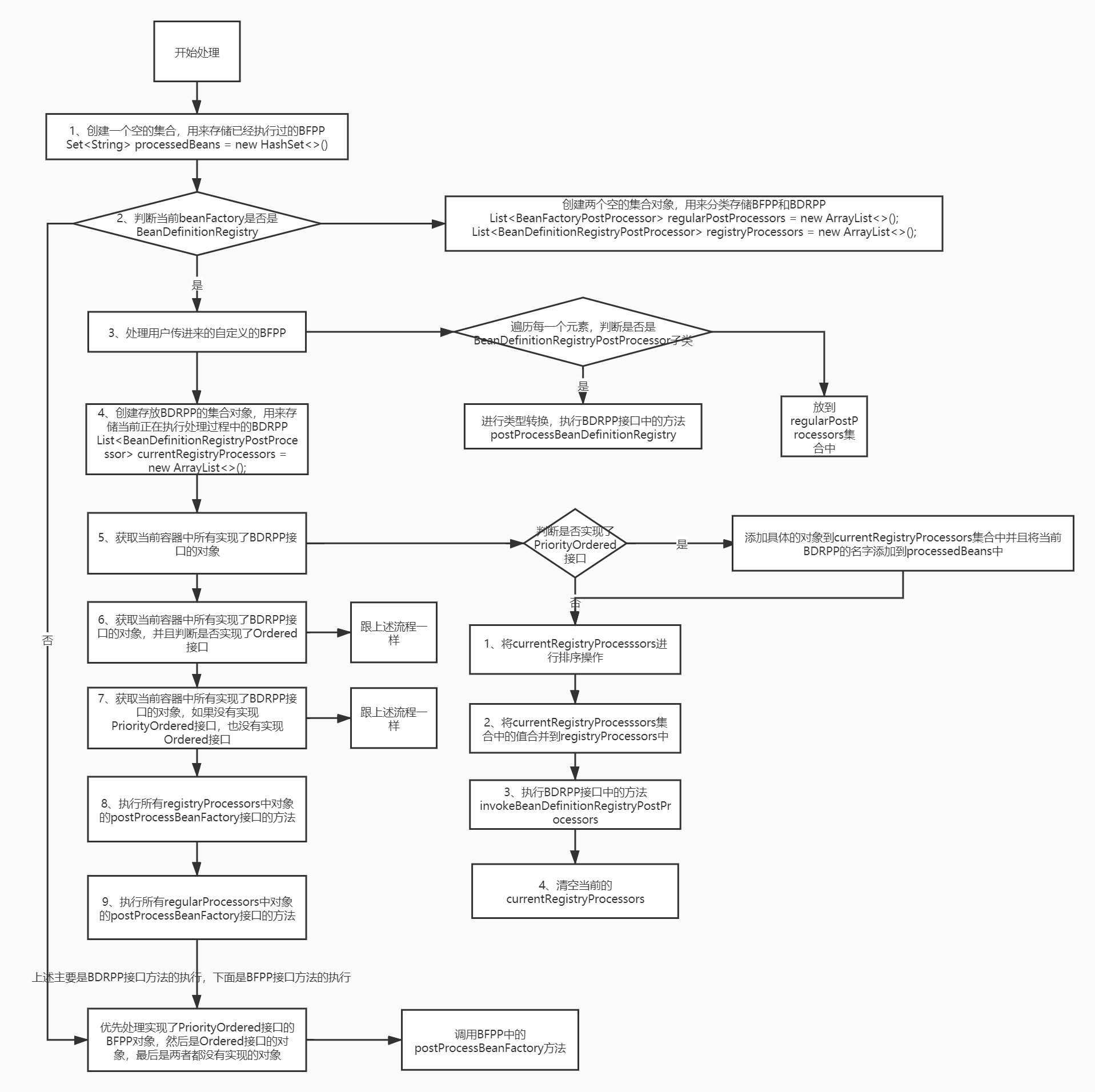Spring系列-2.1 BeanFactoryPostProcessor
Spring版本:Spring 5.2.9.BUILD-SNAPSHOT
修改过部分源码,但不影响主体流程
概述
BeanFactoryPostProcessor
在Spring中BeanFactoryPostProcessor的执行是非常重要的一部分,无论是扫描的实现还是拓展spring都需要涉及到这部分。BeanFactoryPostProcessor的执行时机是在BeanFactory实例化之后,可以通过修改beanFactory来进行增强。
@FunctionalInterface
public interface BeanFactoryPostProcessor {
/**
* Modify the application context's internal bean factory after its standard
* initialization.
*
* 在bean factory标准初始化之后对其进行修改。
*
* All bean definitions will have been loaded, but no beans
* will have been instantiated yet.
*
* 此时所有bean定义已经被加载,但是还没有bean被实例化。
*
* This allows for overriding or adding
* properties even to eager-initializing beans.
*
* 对bean的属性进行重写或者增加修改,甚至对eager-initializing bean也生效。
*
* @param beanFactory the bean factory used by the application context
* @throws org.springframework.beans.BeansException in case of errors
*/
void postProcessBeanFactory(ConfigurableListableBeanFactory beanFactory) throws BeansException;
}
BeanDefinitionRegistryPostProcessor
BeanFactoryPostProcessor的子接口,在常规的BeanFactoryPostProcessor执行之前注册bean定义信息。
/**
* Extension to the standard BeanFactoryPostProcessor SPI, allowing for
* the registration of further bean definitions before regular
* BeanFactoryPostProcessor detection kicks in. In particular,
* BeanDefinitionRegistryPostProcessor may register further bean definitions
* which in turn define BeanFactoryPostProcessor instances.
*
* 标准BeanFactoryPostProcessor SPI的扩展,允许在常规BeanFactoryPostProcessor 检测
* 开始前注册更多的bean定义。尤其值得一提的是,BeanDefinitionRegistryPostProcessor
* 甚至可以注册用来定义BeanFactoryPostProcessor实例的bean定义。
*
* 注意:该接口继承了另外一个接口 BeanFactoryPostProcessor
*
* @作者 Juergen Hoeller
* @开始版本 3.0.1
* @参考 org.springframework.context.annotation.ConfigurationClassPostProcessor
*/
public interface BeanDefinitionRegistryPostProcessor extends BeanFactoryPostProcessor {
/**
* Modify the application context's internal bean definition registry after its
* standard initialization.
* 在应用上下文内部的bean definition registry的标准初始化之后修改对其进行修改。
*
* All regular bean definitions will have been loaded,
* but no beans will have been instantiated yet.
*
* 此时所有常规的bean定义已经被加载,但是还没有bean被实例化。
*
* This allows for adding further
* bean definitions before the next post-processing phase kicks in.
*
* 这样可以在下一阶段post-processing触发之前增加更多的bean定义。
*
* @param registry the bean definition registry used by the application context
* @throws org.springframework.beans.BeansException in case of errors
*/
void postProcessBeanDefinitionRegistry(BeanDefinitionRegistry registry) throws BeansException;
}
常见的BeanFactoryPostProcessor
- ConfigurationClassPostProcessor
-
解析加了@Configuration的配置类
-
解析@ComponentScan扫描的包
-
解析@ComponentScans扫描的包
-
解析@Import注解
-
解析@Bean注解
- PropertySourcesPlaceholderConfigurer
-
属性源装配(environmentProperties,localProperties)
-
占位符解析(解析占位符中的key,将key替换成对应的属性值)
继承关系图

执行时机
- AbstractApplicationContext#invokeBeanFactoryPostProcessors
/**
* 实例化并且调用所有已经注册了的beanFactoryPostProcessor,遵循指明的顺序
*
* Instantiate and invoke all registered BeanFactoryPostProcessor beans,
* respecting explicit order if given.
* <p>Must be called before singleton instantiation.
*/
protected void invokeBeanFactoryPostProcessors(ConfigurableListableBeanFactory beanFactory) {
// 获取到当前应用程序上下文的beanFactoryPostProcessors变量的值,并且实例化调用执行所有已经注册的beanFactoryPostProcessor
// 默认情况下,通过getBeanFactoryPostProcessors()来获取已经注册的BFPP,但是默认是空的,那么问题来了,如果你想扩展,怎么进行扩展工作?
PostProcessorRegistrationDelegate.invokeBeanFactoryPostProcessors(beanFactory, getBeanFactoryPostProcessors());
// Detect a LoadTimeWeaver and prepare for weaving, if found in the meantime
// (e.g. through an @Bean method registered by ConfigurationClassPostProcessor)
if (beanFactory.getTempClassLoader() == null && beanFactory.containsBean(LOAD_TIME_WEAVER_BEAN_NAME)) {
beanFactory.addBeanPostProcessor(new LoadTimeWeaverAwareProcessor(beanFactory));
beanFactory.setTempClassLoader(new ContextTypeMatchClassLoader(beanFactory.getBeanClassLoader()));
}
}
- invokeBeanFactoryPostProcessors(ConfigurableListableBeanFactory, List
)
public static void invokeBeanFactoryPostProcessors(
ConfigurableListableBeanFactory beanFactory, List<BeanFactoryPostProcessor> beanFactoryPostProcessors) {
// Invoke BeanDefinitionRegistryPostProcessors first, if any.
// 无论是什么情况,优先执行BeanDefinitionRegistryPostProcessors
// 将已经执行过的BFPP存储在processedBeans中,防止重复执行
Set<String> processedBeans = new HashSet<>();
// 判断beanfactory是否是BeanDefinitionRegistry类型,此处是DefaultListableBeanFactory,实现了BeanDefinitionRegistry接口,所以为true
if (beanFactory instanceof BeanDefinitionRegistry) {
// 类型转换
BeanDefinitionRegistry registry = (BeanDefinitionRegistry) beanFactory;
// 此处希望大家做一个区分,两个接口是不同的,BeanDefinitionRegistryPostProcessor是BeanFactoryPostProcessor的子集
// BeanFactoryPostProcessor主要针对的操作对象是BeanFactory,而BeanDefinitionRegistryPostProcessor主要针对的操作对象是BeanDefinition
// 存放BeanFactoryPostProcessor的集合
List<BeanFactoryPostProcessor> regularPostProcessors = new ArrayList<>();
// 存放BeanDefinitionRegistryPostProcessor的集合
List<BeanDefinitionRegistryPostProcessor> registryProcessors = new ArrayList<>();
// 首先处理入参中的beanFactoryPostProcessors,遍历所有的beanFactoryPostProcessors,将BeanDefinitionRegistryPostProcessor
// 和BeanFactoryPostProcessor区分开
for (BeanFactoryPostProcessor postProcessor : beanFactoryPostProcessors) {
// 如果是BeanDefinitionRegistryPostProcessor
if (postProcessor instanceof BeanDefinitionRegistryPostProcessor) {
BeanDefinitionRegistryPostProcessor registryProcessor =
(BeanDefinitionRegistryPostProcessor) postProcessor;
// 直接执行BeanDefinitionRegistryPostProcessor接口中的postProcessBeanDefinitionRegistry方法
registryProcessor.postProcessBeanDefinitionRegistry(registry);
// 添加到registryProcessors,用于后续执行postProcessBeanFactory方法
registryProcessors.add(registryProcessor);
} else {
// 否则,只是普通的BeanFactoryPostProcessor,添加到regularPostProcessors,用于后续执行postProcessBeanFactory方法
regularPostProcessors.add(postProcessor);
}
}
// Do not initialize FactoryBeans here: We need to leave all regular beans
// uninitialized to let the bean factory post-processors apply to them!
// Separate between BeanDefinitionRegistryPostProcessors that implement
// PriorityOrdered, Ordered, and the rest.
// 用于保存本次要执行的BeanDefinitionRegistryPostProcessor
List<BeanDefinitionRegistryPostProcessor> currentRegistryProcessors = new ArrayList<>();
// First, invoke the BeanDefinitionRegistryPostProcessors that implement PriorityOrdered.
// 调用所有实现PriorityOrdered接口的BeanDefinitionRegistryPostProcessor实现类
// 找到所有实现BeanDefinitionRegistryPostProcessor接口bean的beanName
String[] postProcessorNames =
beanFactory.getBeanNamesForType(BeanDefinitionRegistryPostProcessor.class, true, false);
// 遍历处理所有符合规则的postProcessorNames
for (String ppName : postProcessorNames) {
// 检测是否实现了PriorityOrdered接口
if (beanFactory.isTypeMatch(ppName, PriorityOrdered.class)) {
// 获取名字对应的bean实例,添加到currentRegistryProcessors中
currentRegistryProcessors.add(beanFactory.getBean(ppName, BeanDefinitionRegistryPostProcessor.class));
// 将要被执行的BFPP名称添加到processedBeans,避免后续重复执行
processedBeans.add(ppName);
}
}
// 按照优先级进行排序操作
sortPostProcessors(currentRegistryProcessors, beanFactory);
// 添加到registryProcessors中,用于最后执行postProcessBeanFactory方法
registryProcessors.addAll(currentRegistryProcessors);
// 遍历currentRegistryProcessors,执行postProcessBeanDefinitionRegistry方法
invokeBeanDefinitionRegistryPostProcessors(currentRegistryProcessors, registry);
// 执行完毕之后,清空currentRegistryProcessors
currentRegistryProcessors.clear();
// Next, invoke the BeanDefinitionRegistryPostProcessors that implement Ordered.
// 调用所有实现Ordered接口的BeanDefinitionRegistryPostProcessor实现类
// 找到所有实现BeanDefinitionRegistryPostProcessor接口bean的beanName,
// 此处需要重复查找的原因在于上面的执行过程中可能会新增其他的BeanDefinitionRegistryPostProcessor
postProcessorNames = beanFactory.getBeanNamesForType(BeanDefinitionRegistryPostProcessor.class, true, false);
for (String ppName : postProcessorNames) {
// 检测是否实现了Ordered接口,并且还未执行过
if (!processedBeans.contains(ppName) && beanFactory.isTypeMatch(ppName, Ordered.class)) {
// 获取名字对应的bean实例,添加到currentRegistryProcessors中
currentRegistryProcessors.add(beanFactory.getBean(ppName, BeanDefinitionRegistryPostProcessor.class));
// 将要被执行的BFPP名称添加到processedBeans,避免后续重复执行
processedBeans.add(ppName);
}
}
// 按照优先级进行排序操作
sortPostProcessors(currentRegistryProcessors, beanFactory);
// 添加到registryProcessors中,用于最后执行postProcessBeanFactory方法
registryProcessors.addAll(currentRegistryProcessors);
// 遍历currentRegistryProcessors,执行postProcessBeanDefinitionRegistry方法
invokeBeanDefinitionRegistryPostProcessors(currentRegistryProcessors, registry);
// 执行完毕之后,清空currentRegistryProcessors
currentRegistryProcessors.clear();
// Finally, invoke all other BeanDefinitionRegistryPostProcessors until no further ones appear.
// 最后,调用所有剩下的BeanDefinitionRegistryPostProcessors
boolean reiterate = true;
while (reiterate) {
reiterate = false;
// 找出所有实现BeanDefinitionRegistryPostProcessor接口的类
postProcessorNames = beanFactory.getBeanNamesForType(BeanDefinitionRegistryPostProcessor.class, true, false);
// 遍历执行
for (String ppName : postProcessorNames) {
// 跳过已经执行过的BeanDefinitionRegistryPostProcessor
if (!processedBeans.contains(ppName)) {
// 获取名字对应的bean实例,添加到currentRegistryProcessors中
currentRegistryProcessors.add(beanFactory.getBean(ppName, BeanDefinitionRegistryPostProcessor.class));
// 将要被执行的BFPP名称添加到processedBeans,避免后续重复执行
processedBeans.add(ppName);
reiterate = true;
}
}
// 按照优先级进行排序操作
sortPostProcessors(currentRegistryProcessors, beanFactory);
// 添加到registryProcessors中,用于最后执行postProcessBeanFactory方法
registryProcessors.addAll(currentRegistryProcessors);
// 遍历currentRegistryProcessors,执行postProcessBeanDefinitionRegistry方法
invokeBeanDefinitionRegistryPostProcessors(currentRegistryProcessors, registry);
// 执行完毕之后,清空currentRegistryProcessors
currentRegistryProcessors.clear();
}
// Now, invoke the postProcessBeanFactory callback of all processors handled so far.
// 调用所有BeanDefinitionRegistryPostProcessor的postProcessBeanFactory方法
invokeBeanFactoryPostProcessors(registryProcessors, beanFactory);
// 最后,调用入参beanFactoryPostProcessors中的普通BeanFactoryPostProcessor的postProcessBeanFactory方法
invokeBeanFactoryPostProcessors(regularPostProcessors, beanFactory);
} else {
// Invoke factory processors registered with the context instance.
// 如果beanFactory不归属于BeanDefinitionRegistry类型,那么直接执行postProcessBeanFactory方法
invokeBeanFactoryPostProcessors(beanFactoryPostProcessors, beanFactory);
}
// 到这里为止,入参beanFactoryPostProcessors和容器中的所有BeanDefinitionRegistryPostProcessor已经全部处理完毕,下面开始处理容器中
// 所有的BeanFactoryPostProcessor
// 可能会包含一些实现类,只实现了BeanFactoryPostProcessor,并没有实现BeanDefinitionRegistryPostProcessor接口
// Do not initialize FactoryBeans here: We need to leave all regular beans
// uninitialized to let the bean factory post-processors apply to them!
// 找到所有实现BeanFactoryPostProcessor接口的类
String[] postProcessorNames =
beanFactory.getBeanNamesForType(BeanFactoryPostProcessor.class, true, false);
// Separate between BeanFactoryPostProcessors that implement PriorityOrdered,
// Ordered, and the rest.
// 用于存放实现了PriorityOrdered接口的BeanFactoryPostProcessor
List<BeanFactoryPostProcessor> priorityOrderedPostProcessors = new ArrayList<>();
// 用于存放实现了Ordered接口的BeanFactoryPostProcessor的beanName
// List<String> orderedPostProcessorNames = new ArrayList<>();
List<BeanFactoryPostProcessor> orderedPostProcessor = new ArrayList<>();
// 用于存放普通BeanFactoryPostProcessor的beanName
// List<String> nonOrderedPostProcessorNames = new ArrayList<>();
List<BeanFactoryPostProcessor> nonOrderedPostProcessorNames = new ArrayList<>();
// 遍历postProcessorNames,将BeanFactoryPostProcessor按实现PriorityOrdered、实现Ordered接口、普通三种区分开
for (String ppName : postProcessorNames) {
// 跳过已经执行过的BeanFactoryPostProcessor
if (processedBeans.contains(ppName)) {
// skip - already processed in first phase above
}
// 添加实现了PriorityOrdered接口的BeanFactoryPostProcessor到priorityOrderedPostProcessors
else if (beanFactory.isTypeMatch(ppName, PriorityOrdered.class)) {
priorityOrderedPostProcessors.add(beanFactory.getBean(ppName, BeanFactoryPostProcessor.class));
}
// 添加实现了Ordered接口的BeanFactoryPostProcessor的beanName到orderedPostProcessorNames
else if (beanFactory.isTypeMatch(ppName, Ordered.class)) {
// orderedPostProcessorNames.add(ppName);
orderedPostProcessor.add(beanFactory.getBean(ppName, BeanFactoryPostProcessor.class));
} else {
// 添加剩下的普通BeanFactoryPostProcessor的beanName到nonOrderedPostProcessorNames
// nonOrderedPostProcessorNames.add(ppName);
nonOrderedPostProcessorNames.add(beanFactory.getBean(ppName, BeanFactoryPostProcessor.class));
}
}
// First, invoke the BeanFactoryPostProcessors that implement PriorityOrdered.
// 对实现了PriorityOrdered接口的BeanFactoryPostProcessor进行排序
sortPostProcessors(priorityOrderedPostProcessors, beanFactory);
// 遍历实现了PriorityOrdered接口的BeanFactoryPostProcessor,执行postProcessBeanFactory方法
invokeBeanFactoryPostProcessors(priorityOrderedPostProcessors, beanFactory);
// Next, invoke the BeanFactoryPostProcessors that implement Ordered.
// 创建存放实现了Ordered接口的BeanFactoryPostProcessor集合
// List<BeanFactoryPostProcessor> orderedPostProcessors = new ArrayList<>(orderedPostProcessorNames.size());
// 遍历存放实现了Ordered接口的BeanFactoryPostProcessor名字的集合
// for (String postProcessorName : orderedPostProcessorNames) {
// 将实现了Ordered接口的BeanFactoryPostProcessor添加到集合中
// orderedPostProcessors.add(beanFactory.getBean(postProcessorName, BeanFactoryPostProcessor.class));
// }
// 对实现了Ordered接口的BeanFactoryPostProcessor进行排序操作
// sortPostProcessors(orderedPostProcessors, beanFactory);
sortPostProcessors(orderedPostProcessor, beanFactory);
// 遍历实现了Ordered接口的BeanFactoryPostProcessor,执行postProcessBeanFactory方法
// invokeBeanFactoryPostProcessors(orderedPostProcessors, beanFactory);
invokeBeanFactoryPostProcessors(orderedPostProcessor, beanFactory);
// Finally, invoke all other BeanFactoryPostProcessors.
// 最后,创建存放普通的BeanFactoryPostProcessor的集合
// List<BeanFactoryPostProcessor> nonOrderedPostProcessors = new ArrayList<>(nonOrderedPostProcessorNames.size());
// 遍历存放实现了普通BeanFactoryPostProcessor名字的集合
// for (String postProcessorName : nonOrderedPostProcessorNames) {
// 将普通的BeanFactoryPostProcessor添加到集合中
// nonOrderedPostProcessors.add(beanFactory.getBean(postProcessorName, BeanFactoryPostProcessor.class));
// }
// 遍历普通的BeanFactoryPostProcessor,执行postProcessBeanFactory方法
// invokeBeanFactoryPostProcessors(nonOrderedPostProcessors, beanFactory);
invokeBeanFactoryPostProcessors(nonOrderedPostProcessorNames, beanFactory);
// Clear cached merged bean definitions since the post-processors might have
// modified the original metadata, e.g. replacing placeholders in values...
// 清除元数据缓存(mergeBeanDefinitions、allBeanNamesByType、singletonBeanNameByType)
// 因为后置处理器可能已经修改了原始元数据,例如,替换值中的占位符
beanFactory.clearMetadataCache();
}
总结
代码很长,贴图更好说明执行流程



